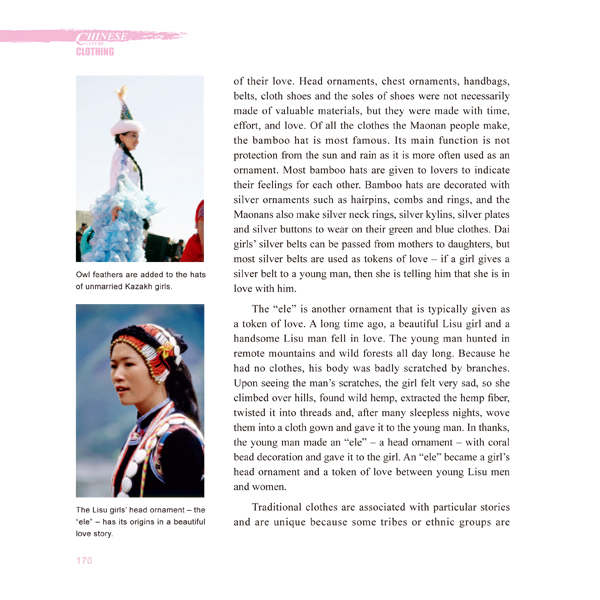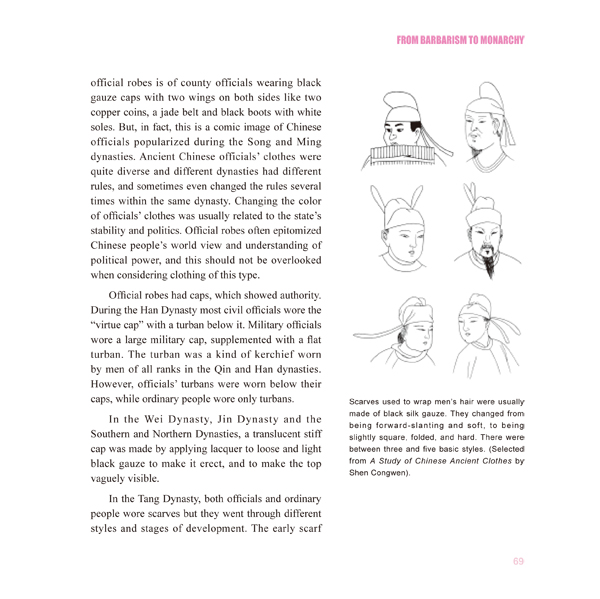中国文化系列丛书:中国文化·服饰(英) 下载 pdf 百度网盘 epub 免费 2025 电子书 mobi 在线

中国文化系列丛书:中国文化·服饰(英)电子书下载地址
内容简介:
中国人习惯把日常生活概括为“衣食住行”,服饰排在了**位,可见它在生活中的重要位置。在这个历史悠久的衣冠大国,从古至今,伴随着民族间的相互融合和东西方文化的交流,服饰的样式和穿着习俗始终在不断演变。
书籍目录:
Contents
Preface: Beautiful Chinese Clothes
From Barbarism to Monarchy
From Ancient One-piece Dresses to Casual Garments and Gowns
Incredible Silk
Imperial Clothes and Culture
Reforming Military Clothing – King Wuling of Zhao
Loose Clothes and Broad Bands
Beautiful Tang Suits
Elegant and Comfortable Casual Clothes
Official Robes
End of Monarchy – Western Clothes Come to the East
Cutting Plaits and Releasing Feet
The Coexistence of Chinese and Western-style Clothes
Improved Cheongsams Combining Chinese and Western Features
Modern Clothes
Workers’ Clothes and Farmers’ Clothes
Military Dress
Bell-bottoms and Sunglasses
Jeans and Denim
作者介绍:
华梅,天津师范大学教授,华梅服饰文化学研究所所长,原美术与设计学院院长。1983年起从事中国服装史教学,1994年创建服饰文化学新学科。至今出版专著56部,代表著作有《人类服饰文化学》《服饰与中国文化》《中国服装史》《西方服装史》《服装美学》等。
出版社信息:
暂无出版社相关信息,正在全力查找中!
书籍摘录:
Official Robes
Ancient China was a feudal society with a rigid hierarchy. This hierarchy was clearly reflected in its clothing. Because ruling regimes needed stability and stability in turn required order, such order was manifested in clothes, especially officials’ clothes. In ancient China, everybody had to abide by clothing rules, which not only involved daily customs, but also constituted a part of the state’s social institutions. All of the dynasties had rules and orders that stipulated the textures, colors, patterns and styles of clothes in detail. Imperial kinsmen’s clothes, civil and military officials’ clothes and ordinary people’s clothes were all strictly separated, and people who violated the rules were punished. This practice of standardizing and limiting the clothes and headwear of various social classes, officials, and ordinary people was obviously intended to maintain the ruling order but also enhanced the culture of Chinese clothes.
A common image of ancient Chinese official robes is of county officials wearing black gauze caps with two wings on both sides like two copper coins, a jade belt and black boots with white soles. But, in fact, this is a comic image of Chinese officials popularized during the Song and Ming dynasties. Ancient Chinese officials’ clothes were quite diverse and different dynasties had different rules, and sometimes even changed the rules several times within the same dynasty. Changing the color of officials’ clothes was usually related to the state’s stability and politics. Official robes often epitomized Chinese people’s world view and understanding of political power, and this should not be overlooked when considering clothing of this type.
Official robes had caps, which showed authority. During the Han Dynasty most civil officials wore the “virtue cap” with a turban below it. Military officials wore a large military cap, supplemented with a flat turban. The turban was a kind of kerchief worn by men of all ranks in the Qin and Han dynasties. However, officials’ turbans were worn below their caps, while ordinary people wore only turbans.
In the Wei Dynasty, Jin Dynasty and the Southern and Northern Dynasties, a translucent stiff cap was made by applying lacquer to loose and light black gauze to make it erect, and to make the top vaguely visible.
In the Tang Dynasty, both officials and ordinary people wore scarves but they went through different styles and stages of development. The early scarf was a low kerchief wrapped on the head. Later, a turban made of phoenix tree wood, silk, vines, grass, and leather was added under the scarf like a fake chignon, giving a fixed scarf shape. From the middle period of the Tang Dynasty, caps with fixed shapes were formed gradually, and they were still called scarves. In the Zhenguan Period, caps with low and flat tops were called the “flat and small style” and were very popular; during the reign of Emperor Gaozong and the reign of Wu Zetian, the top of the scarf was lifted and separated into two petals called the “imperial Wu family style”; during the reign of Emperor Xuanzong, the cap sloped down to the forehead and was called the “Kaiyuan inner style.” The scarf’s two corners, also called feet, at first hung naturally to the neck or below the shoulders like bands. Later, they were gradually shortened, bent upwards, inserted into a knot behind the head, and called the “soft-corner” scarf. After the middle period of the Tang Dynasty scarf corners were round or broad like hard wings curling slightly upwards, and the middle parts were like silk strings. Because they could move, or bounce, these scarf corners were called hard corners or hard feet. It is said that this scarf style became popular because Emperor Wu of the Northern Zhou Dynasty often wore it.
In the Song Dynasty, officials’ scarves extended to the left and right. It is said that they were long so that officials were prevented from whispering to each other when they stood in court.
In the Tang, Song and Ming dynasties, China’s feudal ruling system was at its most sophisticated and in this period officials’ caps changed from the scarves of the Tang and Song dynasties to the black gauze caps of the Ming Dynasty. The style did not change much: the original temporary wrapping style changed into the fixed cap style. This was the point at which the black gauze cap became a symbol associated with officials.
Wearing a scarf or black gauze cap, a round-collared robe (Tang), a round-collared gown (Song) or a coiled-collar robe (Ming), a jade waistband, and black leather boots became the typical image of ancient Chinese officials’ clothes.
The official robes of these three dynasties did not change much in style, and official ranks were related to the color of the clothing. For example, in the fourth year of the Zhenguan Period of the Tang Dynasty (630) and the first year of the Shangyuan Period (674), two decrees made stipulations about clothing colors and ornaments. The second decree was more detailed: “Level-3 and higher civil and military officials’ clothes are purple with 13 ornaments on the gold and jade band; Level-4 officials’ clothes are deep red with 11 ornaments on the gold band; Level-5 officials’ clothes are light red with 10 ornaments on the gold band; Level-6 officials’ clothes are deep green with 9 ornaments on the silver band; Level-7 officials’ clothes are light green with 9 ornaments on the silver band; Level-8 officials’ clothes are deep blue with 9 ornaments on the chalcopyrite band; Level-9 officials’ clothes are light blue with 9 ornaments on the chalcopyrite band.” The Study of the Music of the Tang Dynasty says, “The colors of Tang officials’ clothes depend on their official ranks.” These rules regarding clothing colors lasted until China’s last feudal dynasty – the Qing Dynasty – exited the stage of history, with only minor adjustments throughout its history. During the Ming Dynasty, the rules were at their most detailed, as can be seen in the following table.
在线阅读/听书/购买/PDF下载地址:
原文赏析:
暂无原文赏析,正在全力查找中!
其它内容:
编辑推荐
几乎从服饰出现的那天起,人们的社会身份、生活习俗、审美情趣,以及种种文化观念就已融入其中了。服饰的面貌是社会历史风貌*直观、写实的反映,从这个意义上说,服饰的历史也是一部生动的文明发展史。
书摘插图




前言
Preface: Beautiful Chinese Clothes
Chinese clothing can be traced back to the primitive society of the late Paleolithic Period. Archaeologists have found that 20,000 years ago primitive people who lived near modern-day Zhoukoudian, Beijing, wore ornaments. The white small stone beads, yellowish green cobbles, animal teeth, blood clams and fish bones with furrows unearthed at Zhoukoudian are exquisitely pierced, and traces of hematite powder remain on hole walls. According to the places where they have been found, experts think that these items were necklaces. These people wore ornaments not just for decoration but also to ward off evil spirits and as part of prayer rituals. Long round openings still remain on unearthed bone needles, which demonstrate that ancient people of this period could sew animal hide with needles.
In Qinghai Province, in the west of China, painted pottery basins made more than 5,000 years ago have been unearthed. The patterns on these pottery basins look like dancers doing a hunting dance. The dancers wear plaited ornaments on their heads, tail ornaments hang around their waists, and some wear round skirts. A painted pottery bottle unearthed in Gansu also attracts the attention – it is painted to resemble a girl, with short hair on the forehead above the eyebrows, shoulder-length hair at the back of the head, clearly discernable facial features, and continuous patterns below the neck consisting of three layers of oblique lines, arcs, and triangles. It is thought that these patterns depict clothing.
Chinese clothing and head gear was formalized during the Western Zhou Dynasty (1046–771 BC). The Zhou Dynasty established official positions such as the “clothes minister,” “inner clothes minister” and “jade official”, responsible for the clothes and jade ornaments of the emperor and empress. There were different clothing rules for the emperor and for ordinary people. From the Han Dynasty (206 BC–220 AD) onwards these rules were recorded in official history books such as Records of Carriages and Clothing.
During the Tang Dynasty (618–907) China was powerful, society was more open, and clothes were beautiful. Fashions changed more frequently and women wearing low-neck short gowns or men wearing narrow-sleeved dresses became a symbol of the greater social tolerance of the period. The Tang Dynasty was the most splendid era of Chinese clothing.
After 1840, China became a modern society as the number of trading ports increased and more cosmopolitan cities, such as Shanghai, saw the integration of Chinese and Western cultures. Driven by European and American fashion trends, traditional Chinese clothes began to change.
In the first half of the 20th century, Chinese clothes underwent a period of integration with Western clothing and this fusion can be seen in cheongsams, long gowns, tunic suits, school uniforms, Western-style clothes, hats, silk stockings, and high-heeled shoes. After the founding of the People’s Republic of China in 1949, clothes that elevated the status of laborers, such as workers’ clothes and farmers’ clothes emerged. In the 1980s, after China began to reform and open up to the rest of the world, jackets, bell-bottomed pants, jeans, miniskirts, bikinis, professional suits, punk clothes, T-shirts, etc. were embraced by the Chinese people. Clothes, like people, have been witness to changing times.
China is a multinational country (with 56 different ethnic groups) and clothing styles and customs are constantly changing – like flowers in a garden, always providing color, interest and beauty.
网站评分
书籍多样性:4分
书籍信息完全性:6分
网站更新速度:3分
使用便利性:9分
书籍清晰度:6分
书籍格式兼容性:8分
是否包含广告:5分
加载速度:3分
安全性:7分
稳定性:9分
搜索功能:6分
下载便捷性:9分
下载点评
- 体验差(158+)
- 图书多(218+)
- 小说多(312+)
- mobi(241+)
- 值得下载(290+)
- 书籍多(336+)
- 简单(178+)
- 五星好评(382+)
- 无多页(216+)
- 章节完整(339+)
- 书籍完整(278+)
下载评价
- 网友 晏***媛: ( 2025-01-15 20:45:18 )
够人性化!
- 网友 寇***音: ( 2025-01-01 12:55:36 )
好,真的挺使用的!
- 网友 焦***山: ( 2024-12-24 04:20:06 )
不错。。。。。
- 网友 汪***豪: ( 2025-01-06 01:06:11 )
太棒了,我想要azw3的都有呀!!!
- 网友 常***翠: ( 2025-01-12 05:24:15 )
哈哈哈哈哈哈
- 网友 濮***彤: ( 2024-12-20 22:42:44 )
好棒啊!图书很全
- 网友 曾***文: ( 2025-01-08 16:39:09 )
五星好评哦
- 网友 戈***玉: ( 2024-12-22 05:52:05 )
特别棒
- 网友 游***钰: ( 2025-01-08 15:02:07 )
用了才知道好用,推荐!太好用了
- 网友 师***怡: ( 2025-01-18 20:56:48 )
说的好不如用的好,真心很好。越来越完美
- 网友 隗***杉: ( 2024-12-22 05:18:46 )
挺好的,还好看!支持!快下载吧!
- 网友 丁***菱: ( 2025-01-01 04:49:21 )
好好好好好好好好好好好好好好好好好好好好好好好好好
- 网友 堵***洁: ( 2025-01-03 20:13:13 )
好用,支持
- 网友 印***文: ( 2025-01-03 15:04:21 )
我很喜欢这种风格样式。
喜欢"中国文化系列丛书:中国文化·服饰(英)"的人也看了
- 税收竞争格局效应及对策分析--基于中国财政分权实践的研究 下载 pdf 百度网盘 epub 免费 2025 电子书 mobi 在线
- 9787229076108 下载 pdf 百度网盘 epub 免费 2025 电子书 mobi 在线
- 油画人物教学 袁元 著 重庆出版社【正版保证】 下载 pdf 百度网盘 epub 免费 2025 电子书 mobi 在线
- 夏书章行政管理学<第6版>笔记和考研真题详解(管理类修订版)/国内外经典教材辅导系列 下载 pdf 百度网盘 epub 免费 2025 电子书 mobi 在线
- 蜘蛛侠:重披黑衣 下载 pdf 百度网盘 epub 免费 2025 电子书 mobi 在线
- 中国民生问题中的结构性矛盾研究 下载 pdf 百度网盘 epub 免费 2025 电子书 mobi 在线
- 21小时熟记新日本语能力测试N3核心词汇 下载 pdf 百度网盘 epub 免费 2025 电子书 mobi 在线
- 一本书看透环保税 下载 pdf 百度网盘 epub 免费 2025 电子书 mobi 在线
- 读经典名著记GRE单词 呼啸山庄 胡敏【正版保证】 下载 pdf 百度网盘 epub 免费 2025 电子书 mobi 在线
- MasterCAM X3实体设计与数控加工项目案例解析(配光盘)(CAD/CAM/CAE基础与实践) 下载 pdf 百度网盘 epub 免费 2025 电子书 mobi 在线
书籍真实打分
故事情节:8分
人物塑造:9分
主题深度:6分
文字风格:8分
语言运用:6分
文笔流畅:4分
思想传递:9分
知识深度:7分
知识广度:8分
实用性:4分
章节划分:4分
结构布局:9分
新颖与独特:7分
情感共鸣:6分
引人入胜:9分
现实相关:5分
沉浸感:7分
事实准确性:5分
文化贡献:6分